Organizations, like ships at sea, need a clear design, hierarchy, and well-defined processes to navigate sometimes challenging waters and reach their destinations safely.
Ships have different classes to meet different needs—shipping barges, transport vessels, etc.—but they share the need for a clear chain of command and detailed, enforced policies to ensure the vessel is operating at peak safety and efficiency.
This is also true of businesses, which have different sizes and types of organizational structure, but share a need for transparent and effective policies and hierarchies in order to reach their goals.
By understanding how common types of organizational structures are implemented, how they support the organizations using them, and the challenges and advantages they bring, you can decide which is right for your business and begin working toward meeting your goals for greater efficiency, competitive strength, profitability, and more.
What are the Common Types of Organizational Structure?
Every organizational structure is, at its heart, a diagram describing:
- What a company does, i.e. its business activities.
- Who it relies on to perform the tasks that make up its business activities, how their roles relate to one another, and who is responsible for specific components of each business activity.
- How those business activities should be performed to achieve both specific and broad goals for the organization’s short- and long-term success.
These org charts can be either mechanistic—i.e., highly centralized, specialized, and formalized bureaucratic structures with narrow, rigid parameters for control, roles, and authority—or organic—i.e., decentralized, loosely departmentalized structures with minimal specialization and an emphasis on performance and capabilities rather than prescribed roles and functions.
As a rule, mechanistic org charts work well for policy-driven, high-accountability purposes, but can hamper creativity with their strict controls and rigidity.
Organic structures are ideal for startups, small businesses looking to build their brand, and larger companies that need very high flexibility and adaptability to meet changing consumer expectations, market conditions, or competitive challenges.
From small businesses to large organizations like global mega corporations, companies across the globe generally rely on four different types of organizational structures in the mechanistic model: Functional, Divisional, Matrix, and Hybrid.
Functional Structures
Functional structures are those in which team members are grouped into departments based on their shared skill sets, specializations, accountabilities, and goals.
Communication and decision making are improved by both physical proximity and sharing of tools and information.
Examples of functional structure include information technology (IT) and accounting-based organizations.
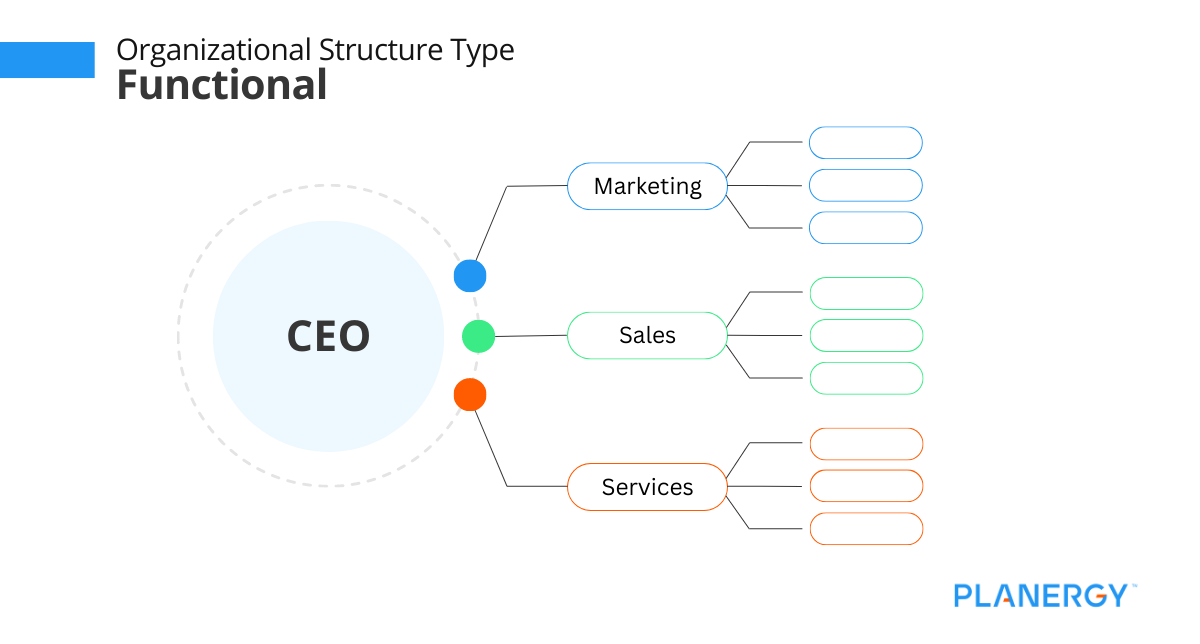
Divisional Structures
Divisional structures focus their attention and activities around specific groups (e.g., markets, goods and services, customer demographics, etc.).
This type of organizational chart allows teams to collaborate on broad, shared organizational goals while maintaining a primary focus on their respective, specific goals.
Examples of divisional structure include geographical (e.g., teams develop similar products with localized customizations for different markets) and product-based (e.g., different divisions all focus on a specific product within a broader product line).
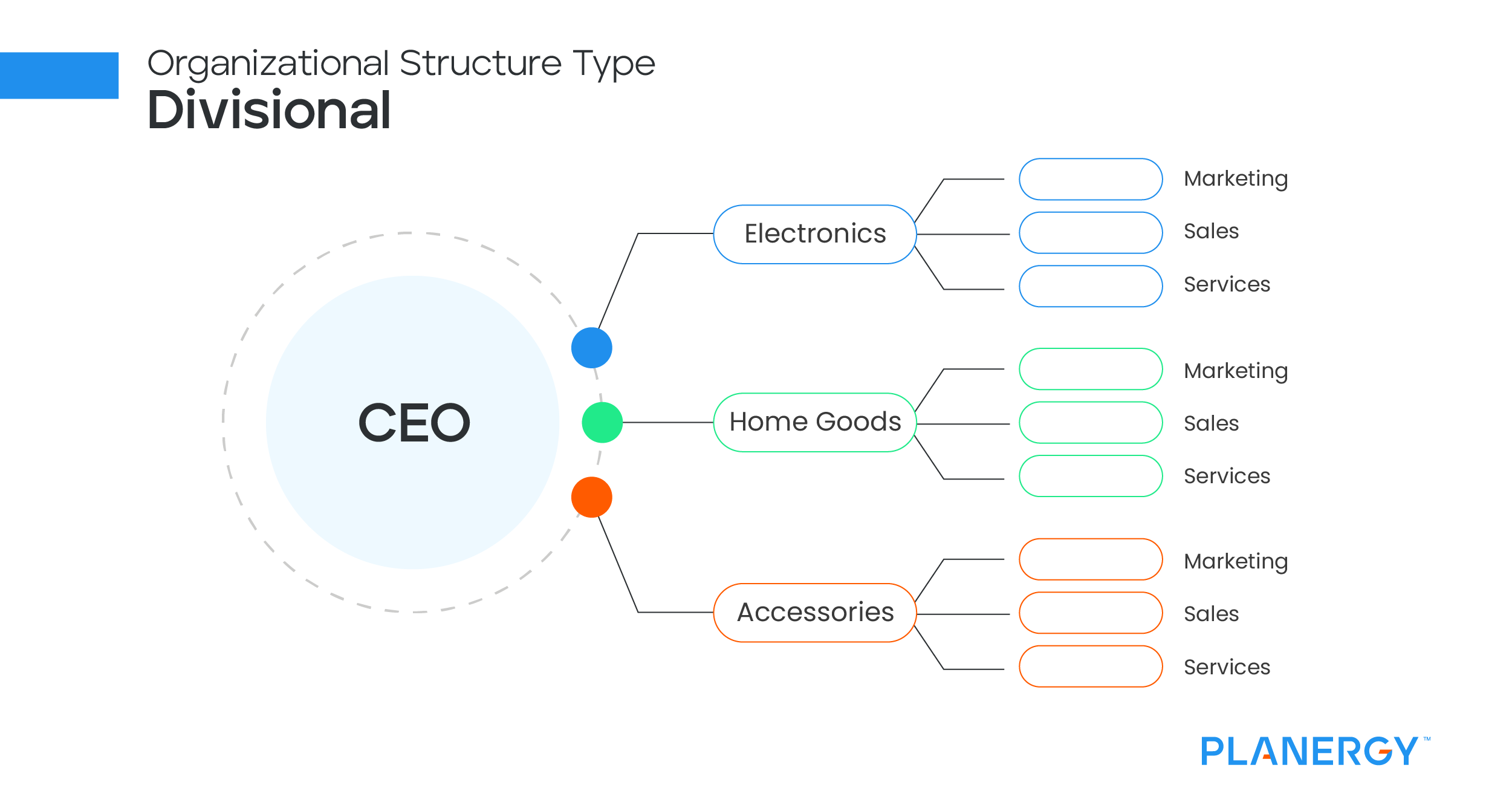
Matrix Structures
Matrix structures combine functional structures with divisional structures in a grid arrangement that combines vertical functions (e.g., organizational roles and titles) with horizontal divisions (e.g., directors of various product lines, projects, etc.).
A matrix organization decentralizes decision-making and provides teams with increased autonomy while simultaneously improving cross-functional collaboration to boost overall productivity and encourage innovative approaches to problem solving.
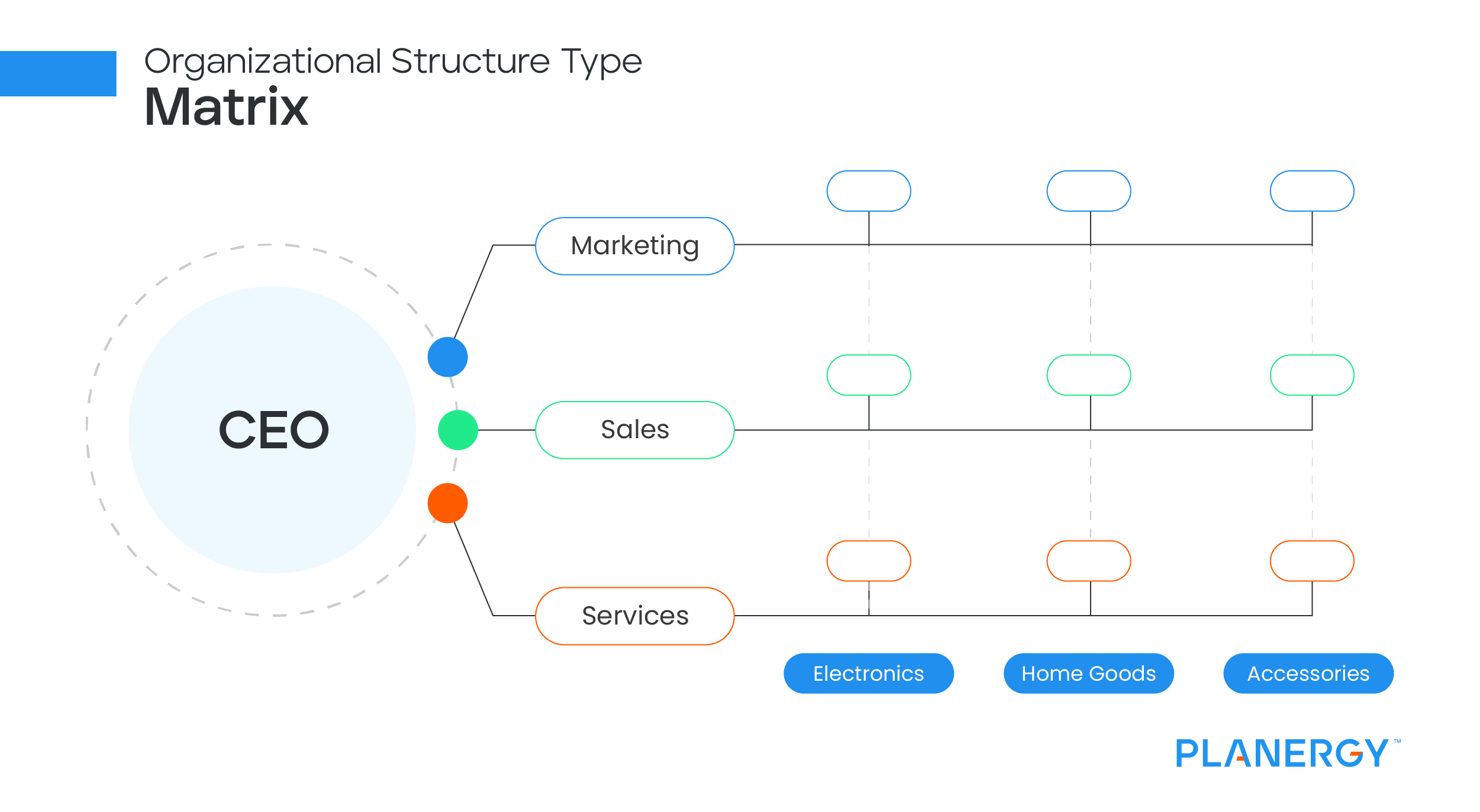
Hybrid Structures
Hybrid structures are similar to matrix structures, but eschew the grid-style org chart in favor of a hierarchical arrangement where business activities can serve either functional or divisional purposes.
This popular approach allows for collaborative sharing of data and resources while preserving division-specific specializations.
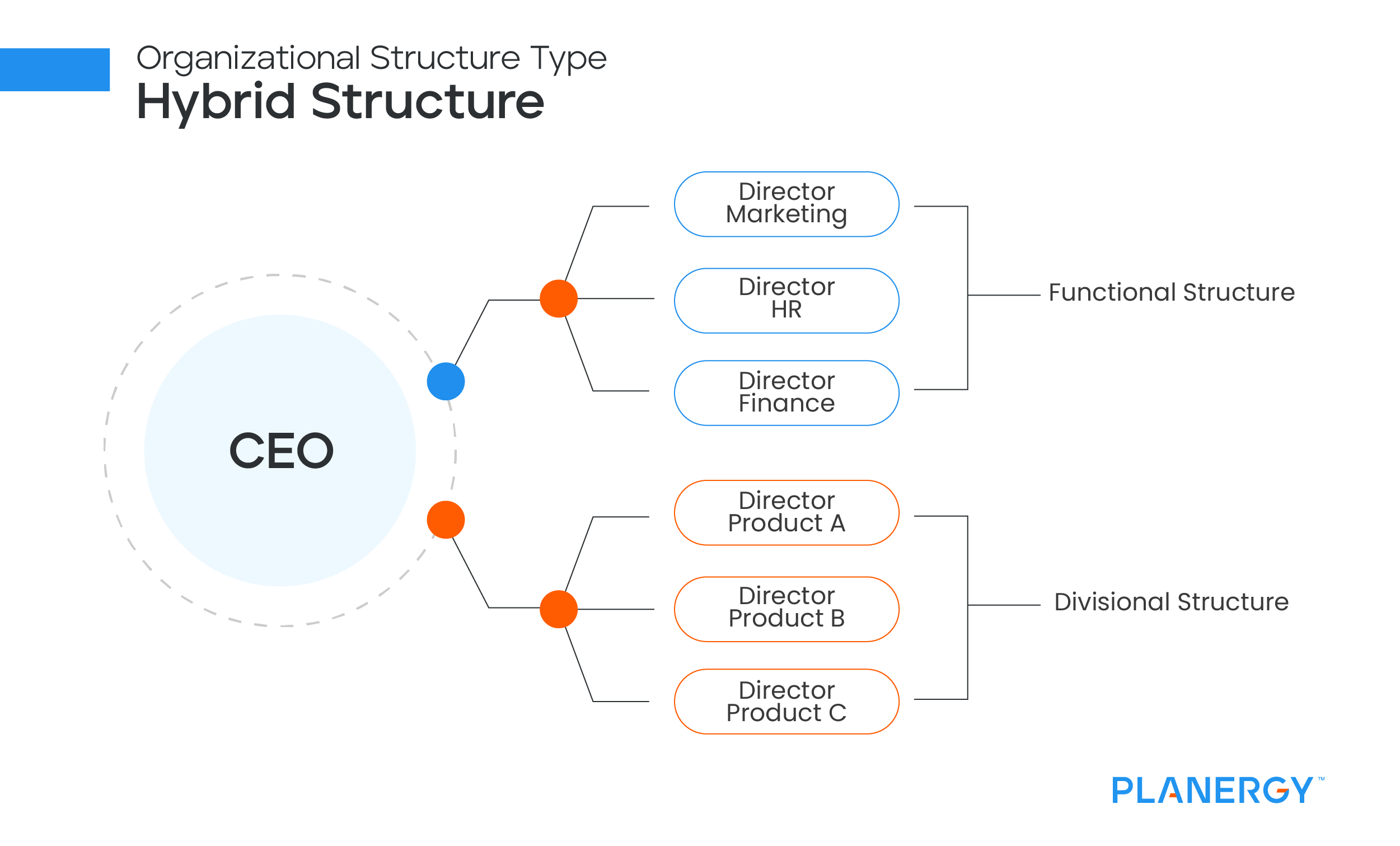
While the “big four” may be the most common, companies around the world also use four other other types of organizational structure which are more organic in nature: Process, Circular, Flat, and Network.
Process Structures
Process structures concentrate on end-to-end workflows for specific processes.
Their procedures and policies seek to optimize the business activities performed by tracking how each different business activity interacts with the others within the hierarchy, as well as how each specific process itself is conducted.
This improves adaptability and flexibility to meet changing demand and market conditions.
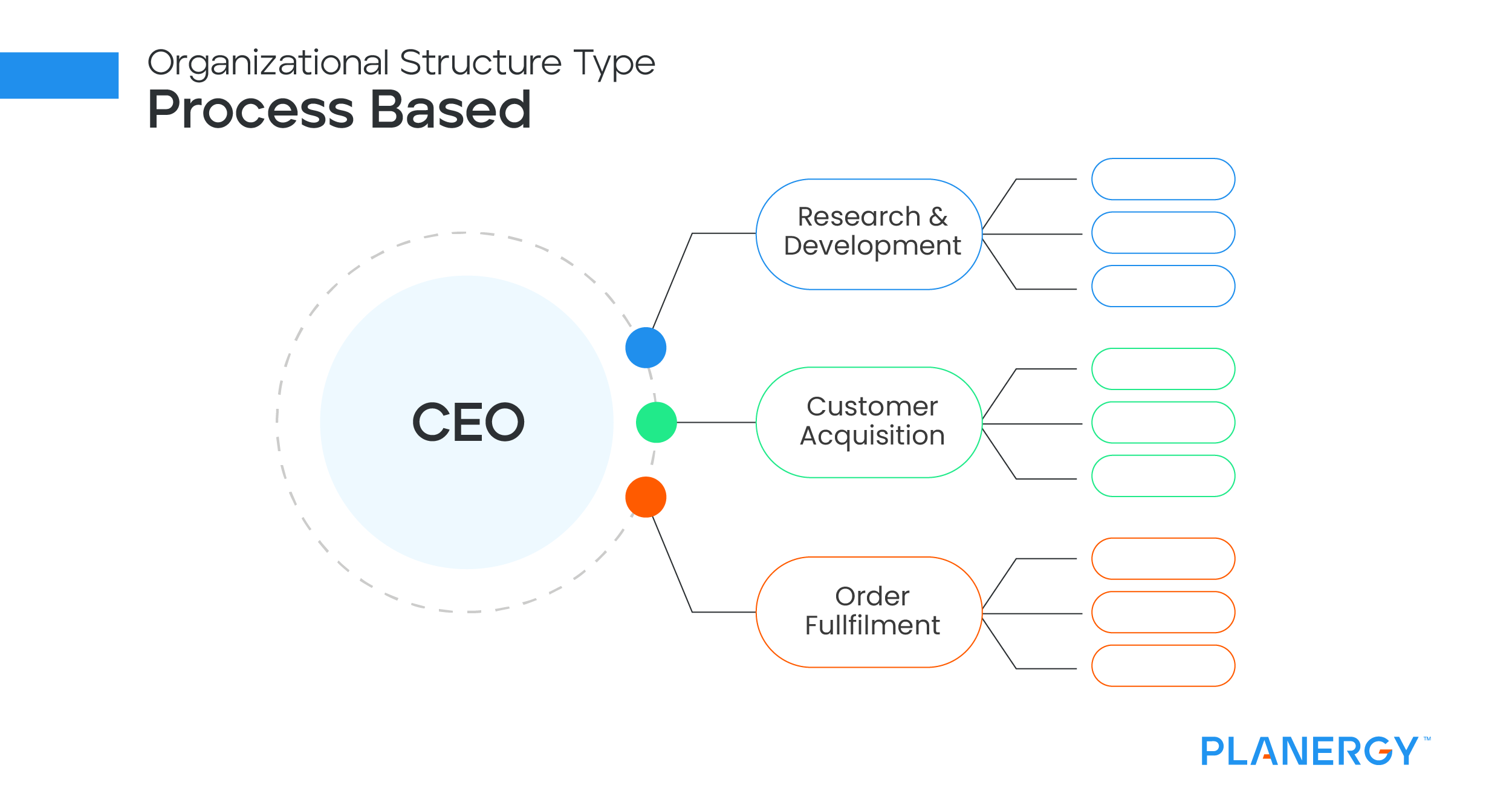
Circular Structures
Circular structures are hierarchical, but rather than a straight ladder arrangement or pyramid, they place high-level employees and leaders at the center and inner rings of a circle and lower-level staff at the outer rings.
This structure is intended to encourage dissemination of information and inspiration from the center and allow different divisions to participate as components of a single whole.
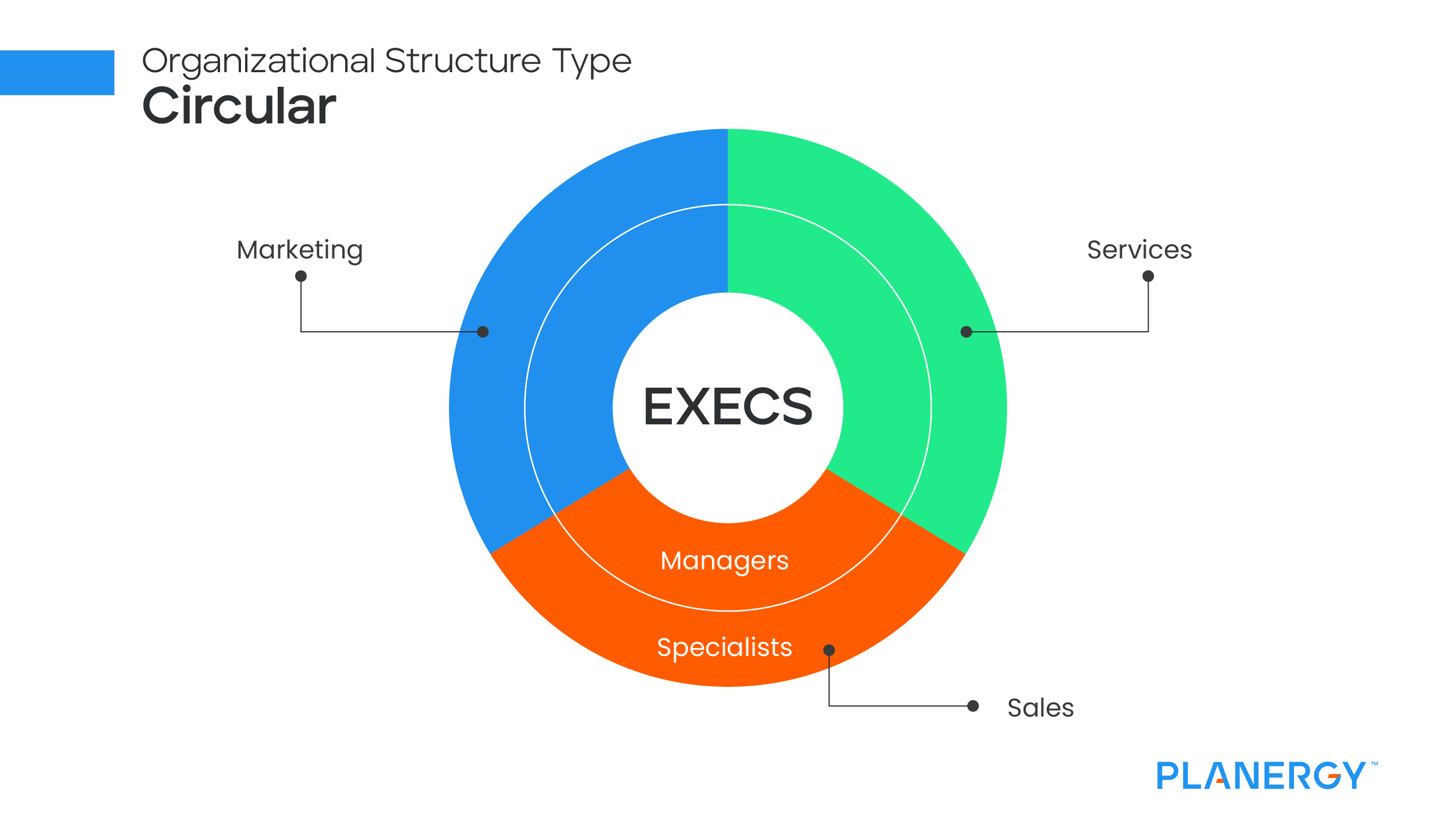
Flat Structures
Flat structures also move away from traditional hierarchy, with a more organic and detailed approach that doesn’t take any one shape.
Instead, they work to minimize authoritative distance between functions and roles by limiting levels of management.
In flat structures, management and executive staff take a more collaborative rather than supervisory role, working and communicating closely with team members and project managers.
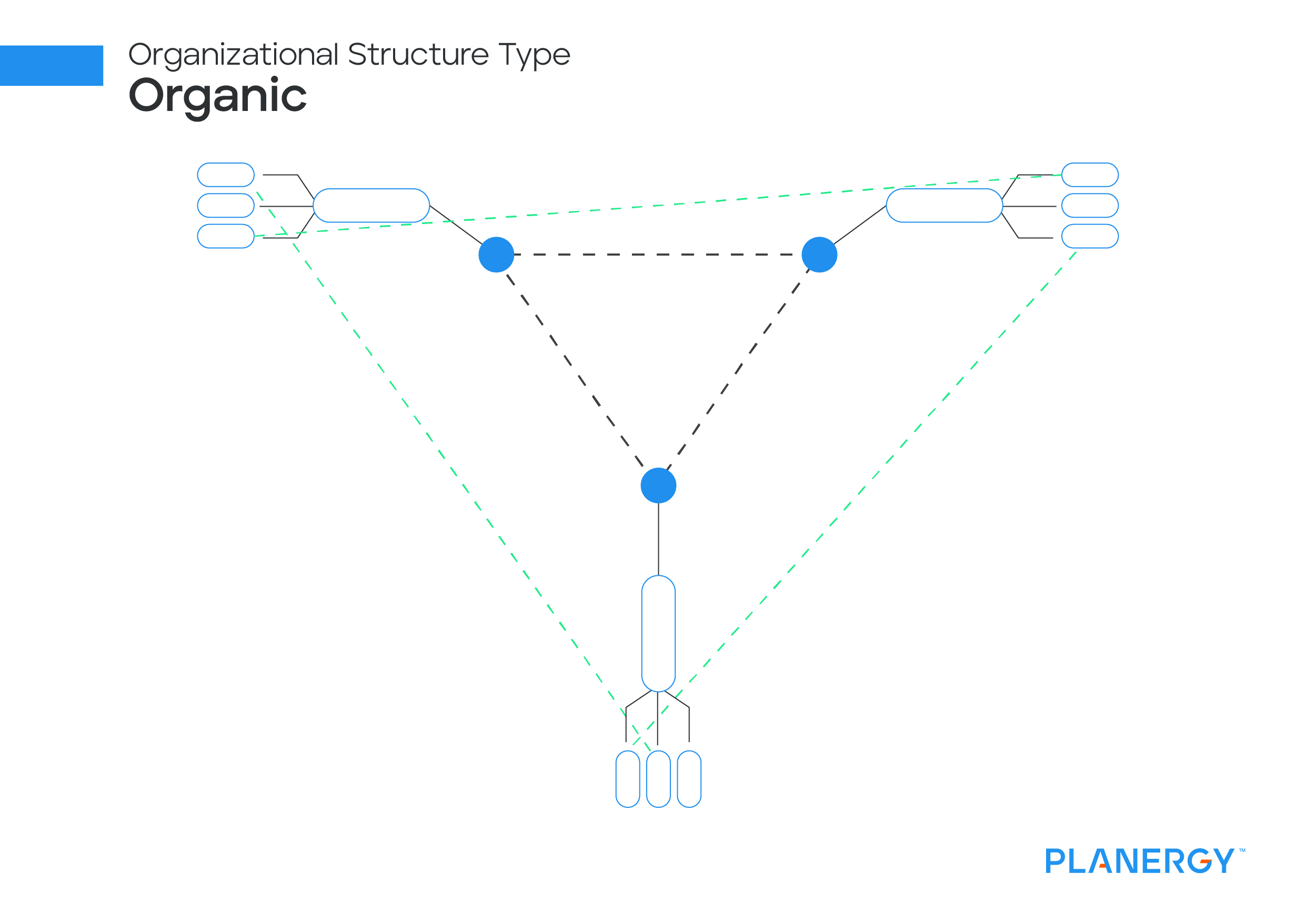
Network Structures
Network structures are a bit different compared to their peers, as they are generally used when an organization collaborates and shares resources with another.
This could take the form of two companies working together, or a large organization with multiple divisions located in various places and with their own leadership and procedures.
Network structures are similar to divisional structures, but instead of product lines or target demographics, they might sort their business activities and roles around specific outsourced services or partnered organizations.
Choosing the right organizational structure for your business begins with understanding the pros and cons of each option and how they affect a company’s business activities.
Pros and Cons of Each Type of Organizational Structure
While there’s no one “right” kind of structure to build a successful business, every business needs an organizational chart if they plan to operate with efficiency, expect accountability, and compete effectively.
Choosing the right organizational structure for your own company begins with understanding the pros and cons of each org chart and how they affect a company’s business activities.
Pros and Cons of Functional Organizational Structures
Pros:
- Supports substantial employee specializations.
- Mechanistic and vertical, functional organizations let employees dedicate time and talents to mastering their roles.
- Simplifies financial analysis, reporting, and overall data management.
Cons:
- Can create silos both for data and communications, decreasing efficiency and creating barriers to task completion.
- Can increase costs in organizations with a large number of products, target markets, etc. by requiring formal policymaking for each.
- Rigidity and highly formal hierarchies can inhibit collaboration and innovation.
Pros and Cons of Divisional Organizational Structures
Pros:
- Allows for quick development and deployment of new products for small companies (product-based divisional structure).
- Versatile and highly specialized for quick, accurate responses to changing consumer behaviors or market intelligence (market-based divisional structure).
- Provides high customization and localization of goods and services to ensure ready availability of incoming goods and services and/or rapid response to meet customer needs (geographical-based divisional structure).
- Shares the functional structure’s simplification of financial analysis and reporting.
Cons:
- Scalability is difficult and silos may lead to duplicated efforts among disconnected divisions (product-based divisional structure).
- Excessive autonomy for teams can duplicate effort (e.g., product development) or create silos that inhibit communication and collaboration (market-based divisional structure).
- Physical distance can create autonomy and decentralization that hamper concerted efforts and instead encourage competition and duplicated effort (geographical-based divisional structure).
Pros and Cons of Matrix Organizational Structures
Pros of Matrix Oraganizational Structures:
- Provides flexible, nuanced collaboration and decision making through dual chains of command.
- Supports shared resources and direct communication across projects and divisions.
- Increased collaboration and communication promote innovation and creativity.
Cons of Matrix Organizational Structures:
- Highly complex; dual/multiple reporting relationships can land a team member on multiple teams, making it difficult to track budgetary demands and resource usage.
- Financial forecasting and analysis can be challenging due to ambiguity of reporting.
- Tracking and optimizing key performance indicators (KPIs) for efficiency, productivity, and spend may be less accurate than is optimal due to the need for estimation.
Pros and Cons of Hybrid Organizational Structures
Pros:
- Versatile and scalable while allowing resources to be allotted and consumed based on either divisional or functional requirements.
- Ideal for small businesses where team members may fill multiple roles.
- Can take advantage of market disruptions more effectively to protect business continuity and seize opportunities to innovate or grow.
Cons:
- Can be complex and emulate the difficulties of the matrix structure model, depending on the configuration used.
- Ambiguity can make it difficult to resolve issues of authority and create interpersonal conflict.
- In complex and large companies, workloads may necessitate additional oversight and management to protect employees from burnout.
Pros and Cons of Process Organizational Structures
Pros:
- Fast and adaptable for a variety of business needs.
- Allows for robust data collection and analysis through both direct tracking of activities and their interactions.
- Provides opportunities to streamline workflows to improve both project- and department-specific processes as well as overall business process management.
Cons:
- Multiple interdependencies can cause delays and damage productivity and efficiency if not managed properly.
- Data and communication silos can develop over time.
- Requires additional resources to ensure effective data collection and management in order to achieve process optimization.
Pros and Cons of Circular Organizational Structures
Pros:
- Provides strong, centralized leadership and vision.
- Supports communication and collaboration across divisions and encourages a spirit of shared purpose to improve resource sharing and decision making.
- Self-sustaining; distribution of duties and strong collaboration insulate against disruptions due to staff changes.
Cons:
- May be confusing for those accustomed to traditional hierarchies.
- May require additional resources and training to ensure optimal buy-in and performance.
Pros and Cons of Flat Organizational Structures
Pros:
- Highly detailed without being rigid.
- Reduces stress that can accompany traditional hierarchies to enhance team spirit and improve collaboration.
Cons:
- High potential for “too many cooks” syndrome: a lack of traditional hierarchies can cause disagreements in flat organizations, halting progress and damaging efficiency and performance.
- Requires extensive planning and detail to be truly effective.
- Will likely require contingency plans for resolving conflicts that cannot be easily addressed to ensure business activities are not disrupted.
Pros and Cons of Network Organizational Structures
Pros:
- Versatile, scalable, and adaptable.
- Allows companies to outsource business activities to free staff to focus on higher-value strategic work.
- Allows companies with multiple satellite locations or far-flung divisions to work together as a comprehensive whole.
Cons:
- Can quickly grow complex, confusing, and difficult to manage without careful planning.
- Requires clear and accessible information on accountability, reporting roles, and specific business activities for a wide range of autonomous locations working with multiple interdependencies.
- High potential for duplication of effort without careful oversight (e.g., multiple locations working on similar products, or multiple marketing departments developing competing campaigns).
Effective Data Management is Essential to All Organizational Structures
Regardless of which org chart provides the foundation for your company’s business activities, one of the most effective tools you can use to ensure your structure is a successful one is a comprehensive software solution that features data management tools as well as next-gen tech like automation, artificial intelligence, and advanced analytics.
Choosing a cloud-based, purpose-built solution like PLANERGY gives you the ability to centralize your data management, automate high-volume processes, and access, analyze, and use your data in real time.
With complete and accurate information and intuitive dashboards, you can set budgets, forecast financials, and generate reports on demand.
You’ll also be able to set KPIs for compliance, performance, and spend, track essential business processes, and make continuous improvement a core component of all your workflows.
And whether your organizational structure is centralized or decentralized, standardizing your workflows and sharing a single datasphere will ensure everyone’s working toward the same goals and following the policies you’ve set for your business.
Implementing such a robust data management system not only enhances operational efficiency but also strengthens decision-making capabilities across the organization, fostering agility and innovation in a competitive business environment.
Both Large and Small Businesses Benefit from Effective Organization Structures
A business attempting to navigate the seas of commerce without an effective organizational structure will soon find itself adrift in unfriendly waters.
Choosing the best org chart for your business will help you monitor and improve your business activities, and ensure everyone on your team is communicating and collaborating effectively to help you achieve your goals for growth, profitability, and competitive performance.




